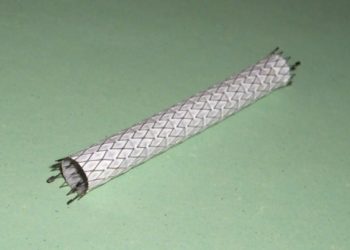Ticagrelor non-superior to clopidogrel in the reduction of PCI-related myocardial necrosis
1. There was no significant difference in periprocedural myonecrosis between ticagrelor and clopidogrel among patients undergoing high-risk elective PCI.
2. Ticagrelor treatment was associated with an increased rate of minor bleeding at 30 days post-operation.
Evidence Rating Level: 1 (Excellent)
Study Rundown: Percutaneous coronary intervention (PCI) provides a safe therapeutic option for patients with coronary artery disease (CAD). However, periprocedural myocardial necrosis, which could delay hospital discharge and increase the likelihood of future major cardiac adverse events, continues to be documented at high rates. The current standard of care for elective PCI includes dual therapy with clopidogrel and aspirin. However, it has been suggested that the use of ticagrelor, which provides a higher level of platelet inhibition than clopidogrel, may mitigate periprocedural complications. This randomized controlled trial examined the effect of ticagrelor versus clopidogrel in reducing periprocedural myocardial necrosis among patients with stable coronary artery disease undergoing high-risk elective PCI. The primary outcome for this study was PCI-related myocardial infarction (type 4a or 4b) and major myocardial injury within 48 hours of operation (or at hospital discharge, if earlier), while the main secondary outcome included any type of myocardial injury. Additionally, safety outcomes included the occurrence of major bleeding, minor or nuisance bleeding, and any bleeding as determined by Bleeding Academic Research Consortium (BARC) criteria. According to study results, no significant difference in the primary outcome was observed between the ticagrelor and clopidogrel group at 48 hours. However, the frequency of minor bleeding events was significantly greater among patients treated with ticagrelor versus clopidogrel. This study was limited by a lack of longitudinal follow-up as patients were only assessed at 48 hours and 30 days post-operation. It would be valuable to compare the risk of cardiac complications among patients in both groups at 12 months. Nonetheless, this study provided important insight into the efficacy of ticagrelor to reduce periprocedural myonecrosis after elective PCI.
Click to read the study in The Lancet
Relevant Reading: Association of Ticagrelor vs Clopidogrel With Net Adverse Clinical Events in Patients With Acute Coronary Syndrome Undergoing Percutaneous Coronary Intervention
In-depth [randomized controlled trial]: Between Jan 9, 2017, and May 28, 2020, 1910 patients were randomly assigned from 49 hospitals in France and Czech Republic. The eligibility criteria included having an indication for PCI and ≥1 high-risk characteristic (age >75, renal insufficiency, diabetes mellitus, BMI >30, history of acute coronary syndrome, etc.). Patients on chronic clopidogrel treatment (maintenance dose for >5 days) were also included. Altogether, 1883 patients (941 in the ticagrelor group and 942 in the clopidogrel group) were included in the analysis. Baseline characteristics were similar between the study groups and clinical outcomes were evaluated at 48 hours and 30 days post-PCI.
At 48 hours, the occurrence of periprocedural myocardial infarction and major myocardial injury was similar in both treatment groups (35% for ticagrelor vs. 36% for clopidogrel, odds ratio [OR] 0.97, 95% confidence interval [CI] 0.80-1.17, p=0.75). This was the case across individual components of the primary outcome and most prespecified subgroups, despite adjusting for established risk factors (i.e., diabetes, renal insufficiency, previous heart failure, etc.). No significant differences between study groups were observed with respect to secondary outcomes (periprocedural myocardial infarction and any form of myocardial injury) and the primary safety outcome (major bleeding) at the 30-day follow-up. However, minor bleeding events were more frequent in the ticagrelor group (105 of 941 patients, 11%) compared to the clopidogrel group (71 of 942 patients, 8%) at 30 days (OR 1.54, 95% CI 1.12-2.11, p=0.0070). Similarly, non-bleeding adverse events were more common in the ticagrelor group (105 of 956 patients, 11%) than the clopidogrel group (5 of 954 patients, <1%), resulting in frequent discontinuation of the study drug in the former (21 of 956 patients, 2%) compared to the latter (4 of 954 patients, <1%). Overall, findings from this study suggest that ticagrelor is not superior to clopidogrel for the reduction of periprocedural myonecrosis and use of clopidogrel as the standard of care for elective PCI should continue until an alternative, more effective, strategy is uncovered.
Image: PD
©2020 2 Minute Medicine, Inc. All rights reserved. No works may be reproduced without expressed written consent from 2 Minute Medicine, Inc. Inquire about licensing here. No article should be construed as medical advice and is not intended as such by the authors or by 2 Minute Medicine, Inc.







